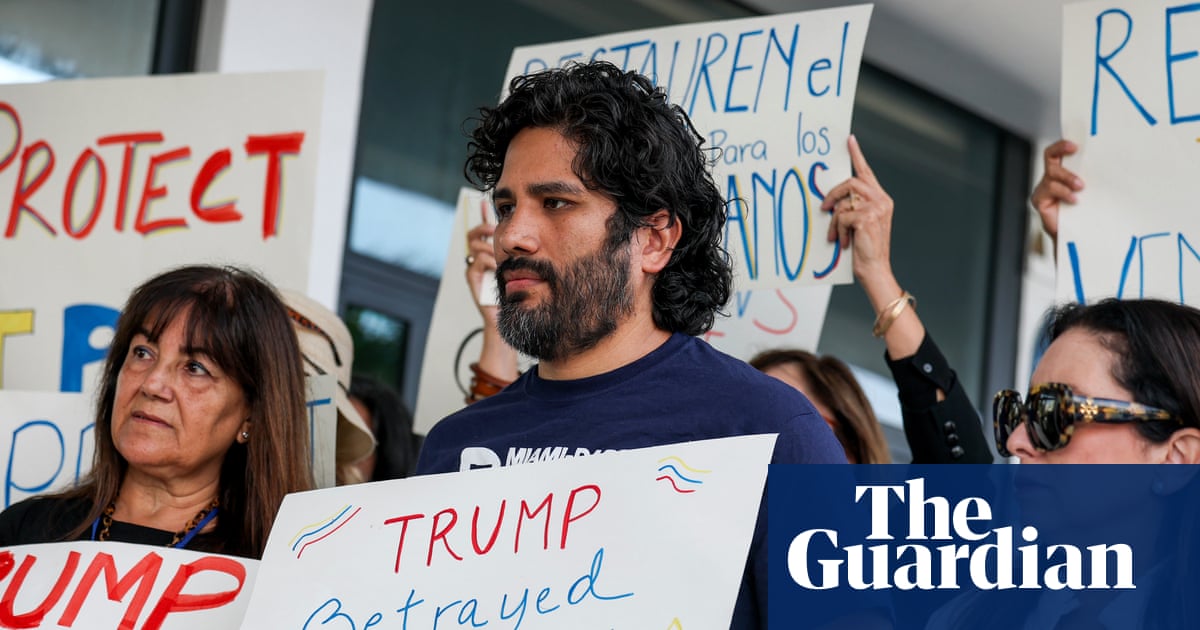As Donald Trump threatens to deploy national guard units to Chicago and Baltimore, ostensibly to quell violence, a pattern has emerged as he describes which cities he talks about.
Chicago, Philadelphia, Washington DC and Baltimore.
But not Jackson, Birmingham, St Louis or Memphis.
An analysis of crime trends over the last four years shows two things. First, violent crime rates in America’s big cities have been falling over the last two years, and at an even greater rate over the last six months. The decrease in violence in America is unprecedented.
Second, crime in large cities in the aggregate is lower in states with Democratic leadership. But the president focuses his ire almost exclusively on large blue cities in blue states, sidestepping political conflict with red Republican governors.
The four cities of populations larger than 100,000 with the highest murder rates in 2024 are in Republican states: Jackson, Mississippi (78.7 per 100,000 residents), Birmingham, Alabama (58.8), St Louis, Missouri (54.1) and Memphis, Tennessee (40.6).
On Tuesday, Trump called Chicago “the most dangerous city in the world”, and pledged to send military troops there, as well as to Baltimore. “I have an obligation. This isn’t a political thing,” he said at a press conference. “I have an obligation when 20 people are killed over the last two and a half weeks and 75 are shot with bullets.”
When talking about crime in Chicago, Trump regularly refers to the number of people who may have been shot and killed there. But Chicago has a population of about 2.7 million, which is larger than each of the least-populous 15 states. It is roughly the same population as Mississippi. Chicago’s homicide rate for 2024 was 17.5 murders for every 100,000 residents, only a few points higher than that of the state of Louisiana, which was 14.5 per 100,000 in 2024.
As has become tradition, news outlets reported how many people were killed in Chicago over the Labor Day weekend. At Louisiana’s rates, one would predict almost twice as many people to have been murdered there over the long weekend.
But those numbers are harder to count. Chicago police report a single figure. One has to scour a hundred local news sites around Louisiana to aggregate the count for comparison.
Notably, Trump discussed sending troops to New Orleans this week. “We’re making a determination now,” Trump said in the Oval Office. “Do we go to Chicago or do we go to a place like New Orleans, where we have a great governor, Jeff Landry, who wants us to straighten out a very nice section of this country that’s become quite, you know, quite tough, quite bad?”
And Landry signaled his willingness to accede. “We will take President Trump’s help from New Orleans to Shreveport!” he wrote on X, posting a clip of the exchange.
Still, Chicago is bracing to be the next city targeted by the Trump administration. To date this year, 278 people have been killed in Chicago, 118 fewer people killed when compared with 2024. It is at pace for 412 deaths for the year, which would be a rate of about 15 per 100,000 residents. The rate is likely to be lower still than that, because homicide rates increase during summer months.
The Windy City ranked 37th in homicide rate in 2024 for cities larger than 50,000 residents in the United States. For cities with more than 100,000 residents, it placed 14th. This year, it is likely to slide farther down the list, even as violence falls to 60-year lows.
As reported by the FBI’s crime data unit in August, the United States had a homicide rate of about 4.6 per 100,000 residents in 2024. It is the lowest figure since 2014, and very close to the generational lows of 4 to 4.5 per 100,000 last experienced in the early 1960s. The pandemic wave of increased violence has largely receded.
“We know that across the nation [violence is] going down,” said Dr Thaddeus Johnson, a former Tennessee police officer and senior fellow at the Council on Criminal Justice, a policy thinktank.
The 2024 homicide rate in the US decreased by about 15%, one of the largest drops in American history. Most of that decrease can be attributed to declines in the largest cities, Johnson said.
Criminal justice researchers tend to place higher value on murder rates than other indicators of violent crime, because murder statistics are harder to manipulate. “It’s the most trustworthy data point,” Johnson said. But it’s not the only data point. “When you start talking about aggravated assaults and robberies, generally, we’ve seen that going down across the nation as well.”
Both Chicago and Baltimore implemented or expanded antiviolence programs in 2022 using American Rescue Plan funding – much of which has been cut under Trump. Baltimore’s homicide rate has fallen about 40% since 2020, and in 2025 is pacing a 50-year low to date.
Violent crime had also been falling in Washington DC by substantial margins before Trump took over the city’s policing. His announcement last month referenced DC’s 2023 crime rates, which spiked during the pandemic, while saying nothing about the precipitous fall since.
In January, the Metropolitan police department and US attorney’s office reported that total violent crime in DC in 2024 was down 35% from the prior year, marking the lowest rate in over 30 years.
The Guardian analyzed the murder rates for the largest 50 cities in the US and found that cities in blue states had the lowest, with just 7.8 murders per 100,000 people. The cities in red states have a much higher murder rate, of 12.9. Cities in swing states sit in the middle, with a murder rate of 10.2.
Baltimore ranks fifth on a list of cities over 50,000 population by murder rate in 2024, as reported to the FBI statisticians. Washington DC is 15th. Between them are Wilmington, Delaware; Detroit; Cleveland; Dayton, Ohio; North Little Rock, Arkansas; Kansas City, Missouri; Shreveport, Louisiana; Camden, New Jersey, and Albany, Georgia.
Compliance with federal rules on crime reporting is incomplete, and some agencies report incomplete data. One notable example of this is Jackson, Mississippi, which has consistently gathered crime data but only started submitting it to the FBI’s system this year. Jackson recorded 111 homicides in 2024, in a population of about 141,000: a rate of 78.7, the highest in America for any city with a population over 50,000.
Though St Louis posted the second-highest homicide rate in 2024, violence there has been falling since 2023, and is on pace today for a 10% annual drop. Its rate will fall less sharply, however, because St Louis is losing population.
Memphis led the country’s homicide rate in 2023. To date in 2025, murders and non-negligent homicides are down about 25%, after a 22% decrease in 2024. Like Baltimore, Memphis leaders attribute the decrease in part to an aggressive gun violence reduction initiative, Memphis Allies.
Notably, small changes in smaller cities can have a big statistical effect.
Birmingham, with a population of about 200,000, has cut its murder rate by more than half since the start of the year. Local officials attribute this, in part, to the arrest of a handful of people accused of violence, including Damien McDaniel, who has been charged in the murders of 18 people as a hired hitman. His arrest in October – and that of four other people who are linked to him – coincides with a 55% drop in Birmingham’s homicide rate since.

 German (DE)
German (DE)  English (US)
English (US)  Spanish (ES)
Spanish (ES)  French (FR)
French (FR)  Hindi (IN)
Hindi (IN)  Italian (IT)
Italian (IT)  Russian (RU)
Russian (RU)  3 hours ago
3 hours ago
























Comments